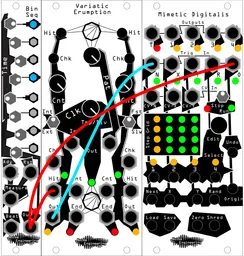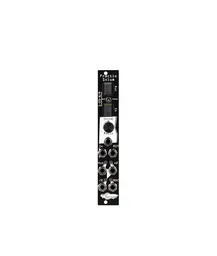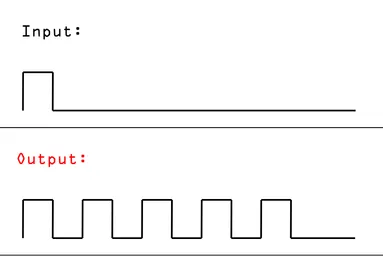Fractio Solum is our 4 HP voltage-controllable clock divider/multiplier. It’s a fun and funky little module, and it can do a whole lot – I have two of them permanently patched in my case, and I use them extensively to do some otherwise tricky things in my sequences. FS was designed to excel at unusual divisions (want a 9 over 5 sequence? No problem!), and especially with the power of voltage control, this opens up a lot of possibilities. Today, we’ll explore three different ways that we can use voltage-controlled clock modification to spice up our sequences.
Variable step-length sequencing
This is one of my favorite techniques to use with any multi-output CV sequencer like Mimetic Digitalis. I usually keep FS in “1” mode, and set its ratio to 1/16: this means that for every 16 clock inputs, we get 1 clock output. Then, we need to do some routing: we need to clock FS, and patch FS’s main Out to our sequencer’s advance input. Finally, one channel of our CV sequencer needs to modulate FS’s Ratio.
Once we have this patched, we can program in a sequence. By controlling FS’s ratio, we can change the length of each step: for instance, if a step stays at 0 volts, it will take 16 clock pulses before it advances, since FS’s ratio will stay at 1/16. If we increase the voltage on the next step, we could set the ratio to, for instance, 1/8, so this step would be twice as quick. This gets especially fun with ratios like 1/3, or ratios in the multiplier range.
We can also patch a 1/16 or 1/64 clock pulse to the reset jacks on FS and our sequencer to keep our sequence to a fixed length, even if our steps are unusually timed.
Let’s hear what this can sound like:
Funky trigger sequencing
While FS is a clock divider, we can do some interesting trigger sequencing with it by CVing its ratios and running its outputs to some drum voices. CV can come from a CV sequencer for repeating patterns, a random CV source like Clep Diaz, or be manually controlled by running CV through an attenuator like Lapsus Os or Sinc Defero.
And we don’t have to limit this to just one FS – I often use both of my FS’s to create even more complex sequences for a whole drum section. Since the divisions and multiplications in FS range from standard to unusual, this technique can generate fantastic rhythms that I often wouldn’t have thought of.
Using the same technique for evolving melodies
It’s also worth mentioning that, if you’re clocking a CV sequencer off of an FS, a great way to create fills is to change the ratio by hand (or with CV) as your patch goes on. Using a consistent /16 or /64 clock division from another divider to reset your sequencer but varying the clock with FS is a great way to create variations on a melody quickly and easily.
Easy tuplets
Another thing that FS makes easy is tuplets. Especially when using more traditional analog sequencers, it can be hard to create any sort of notes that aren’t simple 1/8th or 1/16th notes. FS makes this easy: patch a clock to FS, mult a reset to FS and your sequencer, and set FS’s ratio to something like 1/3 or 1/6.
This technique can be expanded with our first patch – by carefully sequencing the clock ratios of FS, we could have 1/8th notes interspersed with 1/8th triplets, for instance, creating some complex rhythms that are not often heard in a modular context.





